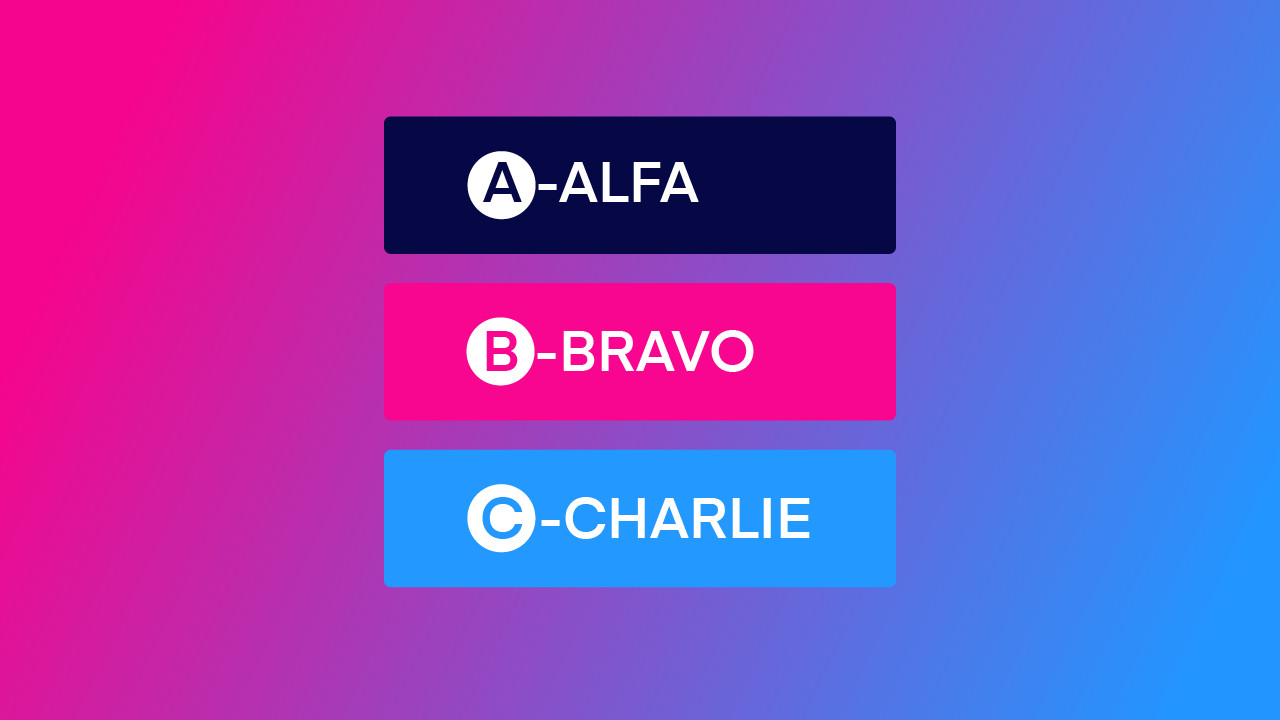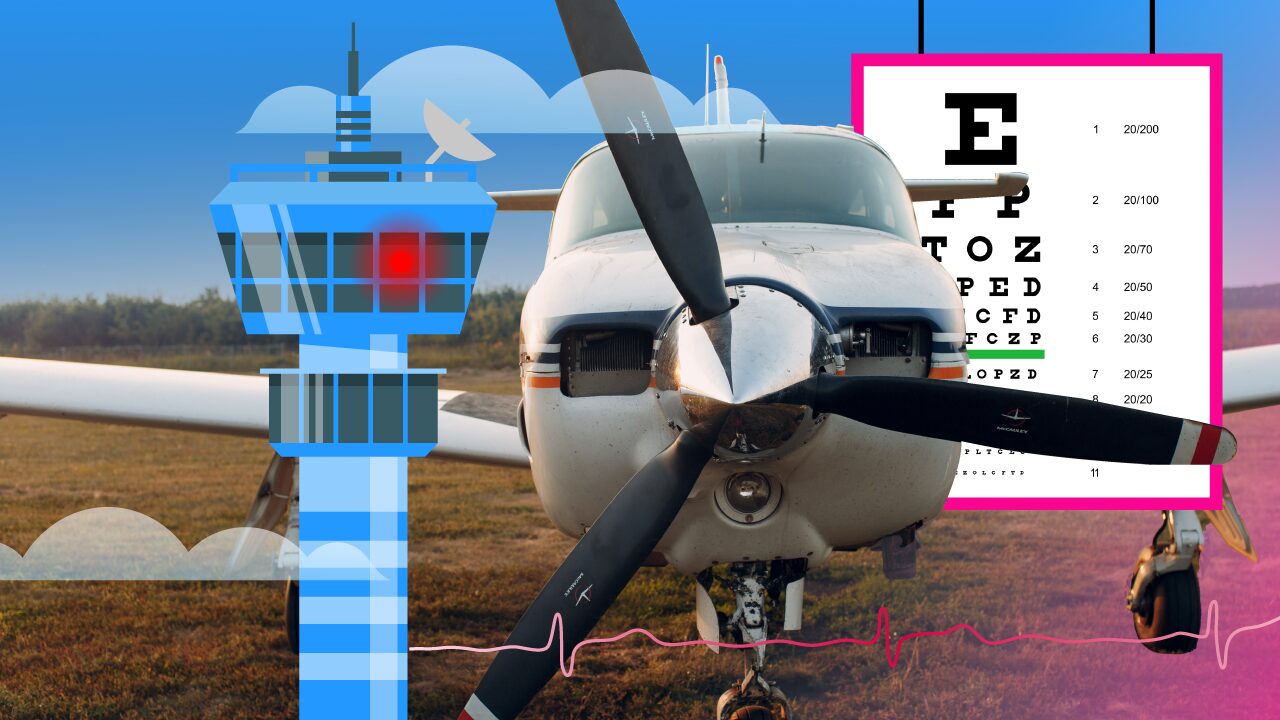-
Key Takeaways
-
What Is the NATO Phonetic Alphabet?
- History of the NATO Phonetic Alphabet
- Why Is It Important To Learn?
-
Easy Tips To Memorize the NATO Phonetic Alphabet
- Tip 1: Figure Out Your Learning Style
- Tip 2: Visualize With Images
- Tip 3: Chunking Method
- Tip 4: Practice With License Plates and Signs
- Tip 5: Make It a Jingle or Song
- Tip 6: Use Flashcards and Apps
- Tip 7: Repetition and Regular Practice
-
Application of the NATO Phonetic Alphabet
- Real-Life Scenarios
- Benefits for Civilians
-
Frequently Asked Questions
- Is it “ALFA” or “ALPHA”?
- What Does "Tango Mike" and "Bravo Zulu" Mean?
- How Can I Memorize the Phonetic Alphabet Quickly?
- Is the NATO Phonetic Alphabet Used Worldwide?
-
Additional Learning Resources
- Online Quizzes and Practice Tests
- Printable Materials and Visual Aids
-
Conclusion
If you’ve ever called customer service, you’ve likely dealt with the hassle of having to spell things out loud. Your “B” would get mixed up with a “V.” In the end, you resort to using arbitrary words starting with the letter just to clarify.
Imagine this fiasco on a busy frequency in crowded airspace while approaching for landing. Now imagine it during a distress situation. Mishaps like this are a recipe for chaos—and worse—disaster.
The solution? The NATO Phonetic Alphabet. It was created to replace letters with universally recognized code words.
There’s nothing arbitrary about it. It’s a standard communication tool that improves clarity not just in aviation, but even in everyday life!
We’ll teach you easy and effective tips for learning the NATO Phonetic Alphabet so you can fly and communicate like a pro pilot.
Key Takeaways
- The NATO Phonetic Alphabet ensures clear communication with standardized code words.
- Utilizing mnemonic devices, visualization, and grouping methods accelerates memorization.
- Regular practice with real-life applications solidifies retention and recall.
- Useful for both professionals and everyday communication.
What Is the NATO Phonetic Alphabet?
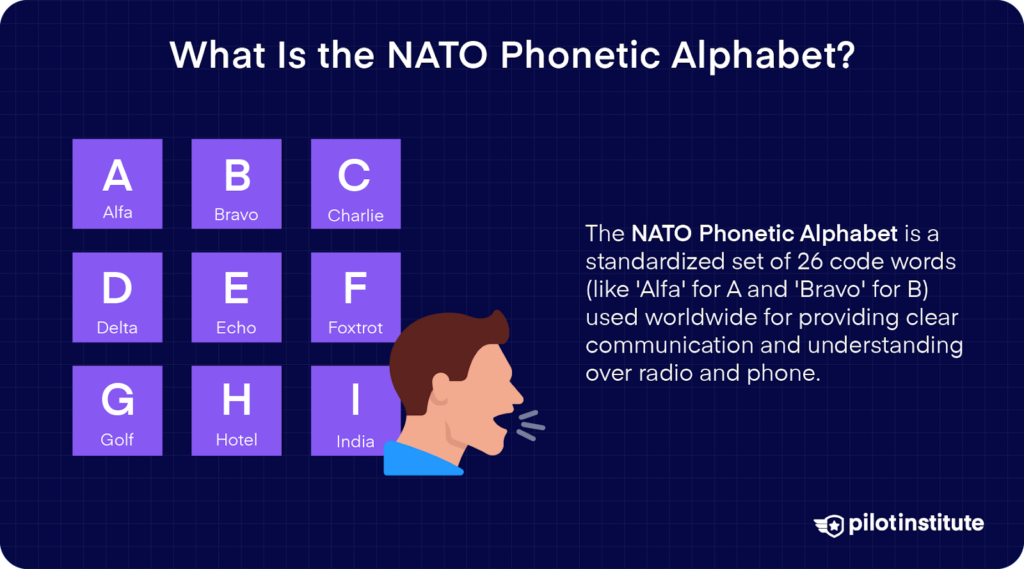
The International Radiotelephony Spelling Alphabet, which we now know as the NATO Phonetic Alphabet, is a standardized set of 26 code words assigned to every letter of the English alphabet. To this day, this system is the most widely used set of clear code words for communicating letters.
What are these code words? Here’s all of them, along with the pronunciation of numbers.
| Character | Telephony | Phonic (Pronunciation) |
| A | Alfa (Alpha) | (AL-FAH) |
| B | Bravo | (BRAH-VOH) |
| C | Charlie | (CHAR-LEE) or (SHAR-LEE) |
| D | Delta | (DELL-TAH) |
| E | Echo | (ECK-OH) |
| F | Foxtrot | (FOKS-TROT) |
| G | Golf | (GOLF) |
| H | Hotel | (HOH-TEL) |
| I | India | (IN-DEE-AH) |
| J | Juliett (Juliet) | (JEW-LEE-ETT) |
| K | Kilo | (KEY-LOH) |
| L | Lima | (LEE-MAH) |
| M | Mike | (MIKE) |
| N | November | (NO-VEM-BER) |
| O | Oscar | (OSS-CAH) |
| P | Papa | (PAH-PAH) |
| Q | Quebec | (KEH-BECK) |
| R | Romeo | (ROW-ME-OH) |
| S | Sierra | (SEE-AIR-RAH) |
| T | Tango | (TANG-GO) |
| U | Uniform | (YOU-NEE-FORM) or (OO-NEE-FORM) |
| V | Victor | (VIK-TAH) |
| W | Whiskey | (WISS-KEY) |
| X | Xray | (ECKS-RAY) |
| Y | Yankee | (YANG-KEY) |
| Z | Zulu | (ZOO-LOO) |
| 1 | One | (WUN) |
| 2 | Two | (TOO) |
| 3 | Three | (TREE) |
| 4 | Four | (FOW-ER) |
| 5 | Five | (FIFE) |
| 6 | Six | (SIX) |
| 7 | Seven | (SEV-EN) |
| 8 | Eight | (AIT) |
| 9 | Nine | (NINE-ER) |
| 0 | Zero | (ZEE-RO) |
But this wasn’t the first naming system that’s been used. It had a long history of trial and error before we got to the phonetic alphabet we have today.
History of the NATO Phonetic Alphabet
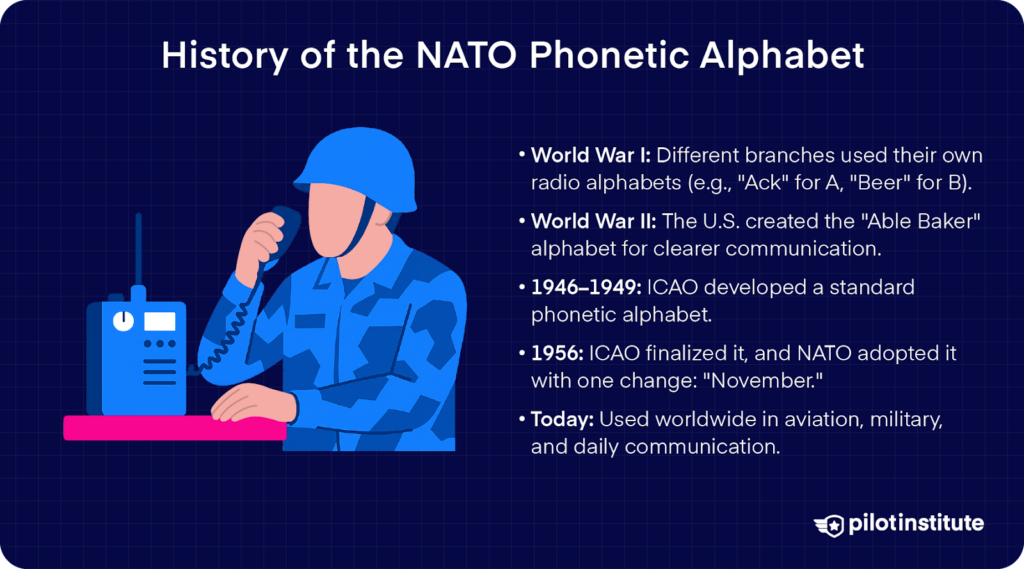
Since World War I, people have sought a clear way to convey letters. At that time, military forces needed to spell out words over the radio.
There were many versions created by different branches of the military. For example, the British Army used words like “Ack” for A and “Beer” for B, while the Royal Navy used “Apples” and “Butter”.
In World War II, the U.S. made the Joint Army/Navy radiotelephony alphabet. This helped make communication clearer in all military branches. It was called “Able Baker,” named after the words used for the letters A and B.
Then, from 1946 to 1949, the ICAO tried to come up with a better spelling alphabet.
By no means, however, was this system perfect. Some people were confused between words like “Delta” and “Extra,” “Nectar” and “Victor,” and had trouble understanding some words when the signal was weak. The issues were so serious that people went back to using the old “Able Baker” alphabet.
How did they fix it? By early 1956, the ICAO had almost finished its research and published a new official phonetic alphabet. This was meant to resolve problems caused by different alphabet systems being used in different places.
At the same time, NATO was working on adopting the ICAO alphabet. They were in a hurry, so they first accepted a slightly different version based on their research in January 1956. But by March, NATO officially switched to the ICAO version, which had only one small change: the word “November.”
Today, the NATO Phonetic Alphabet is used worldwide in aviation, the military, and even by the average telephone caller.
Why Is It Important To Learn?
The NATO Phonetic Alphabet is widely used. You’ll find it in the military, maritime industries, and emergency services. It helps provide clear communication, especially in noisy or chaotic environments. Pilots rely on it for accurate communication with air traffic control. It avoids confusion between similar-sounding letters like “B” and “V.”
Outside of aviation, it’s still a valuable tool for everyday life. You can use it to make your phone calls clearer, especially when spelling names or addresses. It can help you bridge language barriers and it is useful for those with speech or hearing difficulties. Learning it is a quick, practical skill in both personal and professional settings.
Easy Tips To Memorize the NATO Phonetic Alphabet
Twenty-six words may sound like a lot to memorize, but it’s actually easier than you think! Let’s look at some effective tips to master the phonetic alphabet. With enough practice, it’ll start to feel like second nature.
Tip 1: Figure Out Your Learning Style
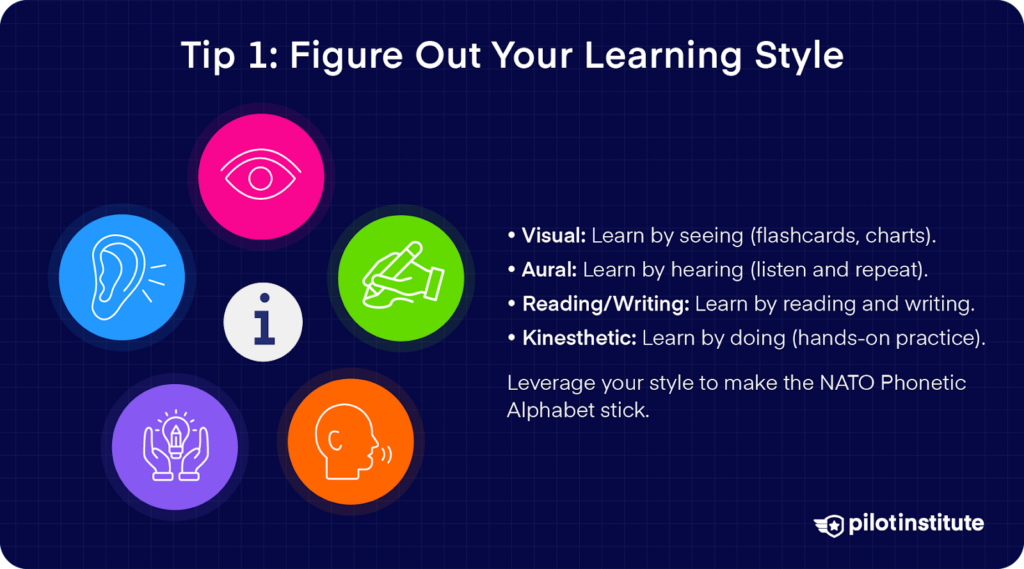
Each person has a unique learning style. Common categories are:
- Visual: learning by seeing.
- Aural: learning by hearing.
- Reading/writing: learning through reading and writing.
- Kinesthetic: learning by doing.
If you know what yours is, you can leverage it when memorizing the phonetic alphabet. Understanding your learning style can make remembering the NATO Phonetic Alphabet simpler and a whole lot more fun.
Each person absorbs information differently, and you know best how your brain works. When you make use of your strengths, you can generate mnemonic devices that stick. The trick is in creating a personalized technique that feels natural to you.
Tip 2: Visualize With Images
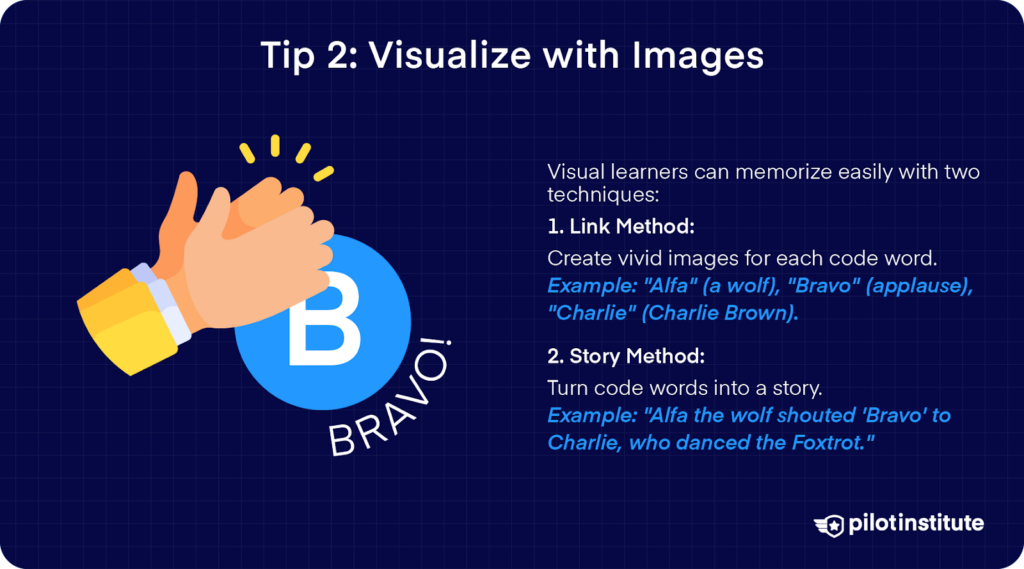
If you’re a visual learner, using mental images can make memorization a whole lot easier. There are actually two visual techniques you can use: the Link Method and the Story Method.
The Link Method
Using the Link Method, you can link each code word to a vivid, memorable image. And since each code is already a word in itself, it’ll be very straightforward and intuitive.
For example, you can visualize an alpha wolf for “Alfa,” people applauding for “Bravo,” or Charlie Brown for “Charlie.”
The Link Method enhances your ability to recall information by forming associations. It’s simple, and you can apply it to different types of information.
The Story Method
Are you into storytelling? Try to make a short story for each code—this is called the Story Method.
You can use something like, “Alfa the wolf shouted ‘Bravo‘ to Charlie the cat. They flew on Delta Airlines, listening for their voices Echo coming over the Foxtrot dance floor.”
What do you think happens next? Try to come up with your own ending for the rest of the letters.
Spinning the words into a story creates a smooth sequence. Aside from that, it’s also more effective since learning becomes more engaging and easier to recall. When you link the code words in a story, it gives your brain a smooth route to take.
Tip 3: Chunking Method
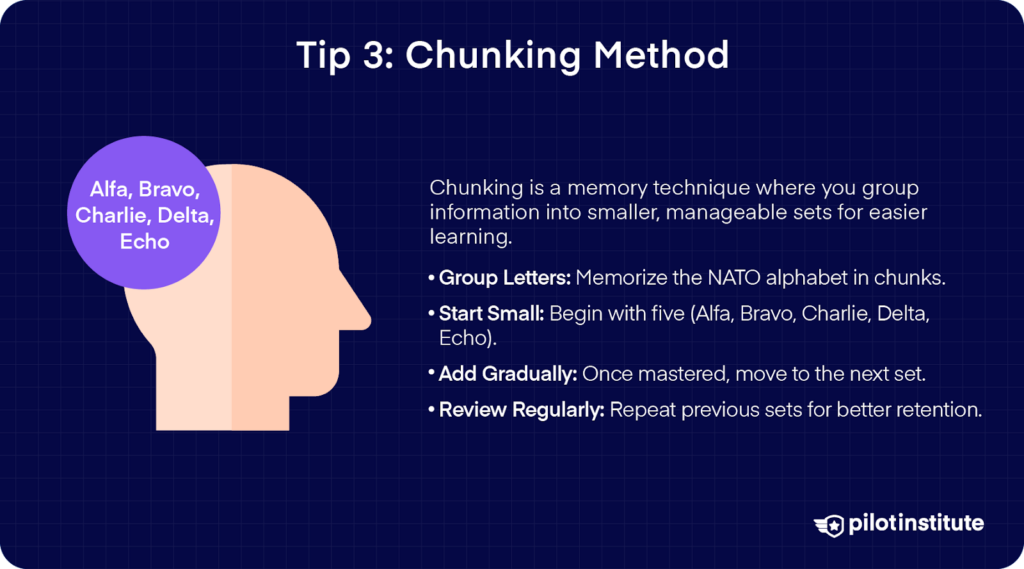
All of these code words can be overwhelming to digest at once. We get it, don’t sweat it.
One easy method of learning the NATO phonetic alphabet is Chunking, where you group information into sections. Rather than trying to memorize each individual code word, you can group them into chunks. Then, try to memorize one group at a time.
How can you do this? Begin with the first five: Alfa, Bravo, Charlie, Delta, and Echo. Focus on this set for a day or two. After mastering it, proceed to the next set: Foxtrot, Golf, Hotel, India, and Juliett. Then, try to recite everything you’ve studied so far, starting from the first set.
Proceed and repeat these steps with Kilo, Lima, Mike, November, and Oscar. Next, tackle Papa, Quebec, Romeo, Sierra, and Tango. Lastly, complete with the remaining six: Uniform, Victor, Whiskey, X-ray, Yankee, and Zulu.
Since the entire alphabet is broken down into manageable chunks, you’ll be less likely to get overwhelmed. You’ll be able to concentrate on one set completely before proceeding, and continue to review prior sets to reinforce your memory.
When you review each set before proceeding to the next one, you get to practice spaced repetition. Take your sweet time and don’t succumb to time pressure. This has been shown to enhance your retention over time.
Tip 4: Practice With License Plates and Signs
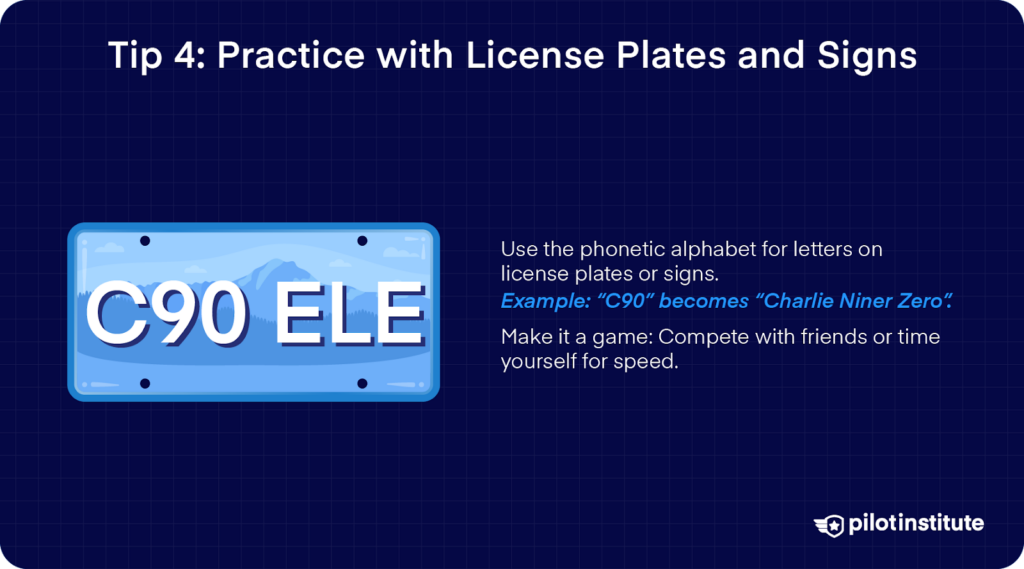
An excellent way to improve on the NATO phonetic alphabet is to practice using what you look at each day. It adds a sense of playfulness to the mundane. Everyday moments become an opportunity to learn and improve.
For instance, the next time you are driving or walking around, try to read off letters from a license plate with the phonetic alphabet. When you see a license plate with the letters “CAT,” you can say “Charlie Alpha Tango” out loud or in your head.
Do this for street signs or large words on signs as well. Such casual practice keeps your brain on its toes, while also improving your speed.
Want to make it more fun? Turn it into a game. Challenge yourself or a friend to spell random words with the phonetic code, and compete for the highest score. You can even time yourself or challenge your own speed. The idea is to make practice something you look forward to doing every day.
Tip 5: Make It a Jingle or Song

Are you more musically inclined? If you’re someone who remembers lyrics better than lists, turning the NATO phonetic alphabet into a song can be a game-changer.
You might have heard a song on the radio that has unexpectedly brought back old memories. The same principle applies here. Music taps into rhythm and melody to help recall information. We’d wager it’s probably how you memorized your ABCs as a child.
Pick a familiar tune like “Twinkle, Twinkle, Little Star” or the ABC song. Then, substitute the lyrics with the phonetic code words. Something like, “Alfa, Bravo, Charlie, and—Delta, Echo, Foxtrot, Golf—Hotel, India, Juliett—Kilo, Lima-Mike, November—Oscar, Papa, Quebec, Romeo—Sierra, Tango, Uniform…” and keep going!
Is pop or rock more your speed? Put your own spin and use a melody from a song you enjoy. If you really feel like getting creative, you can even compose your own melody. Just keep it brief and memorable.
Your jingle doesn’t need to be flawless; it just needs to be catchy enough that repetition becomes less of a drag.
Tip 6: Use Flashcards and Apps
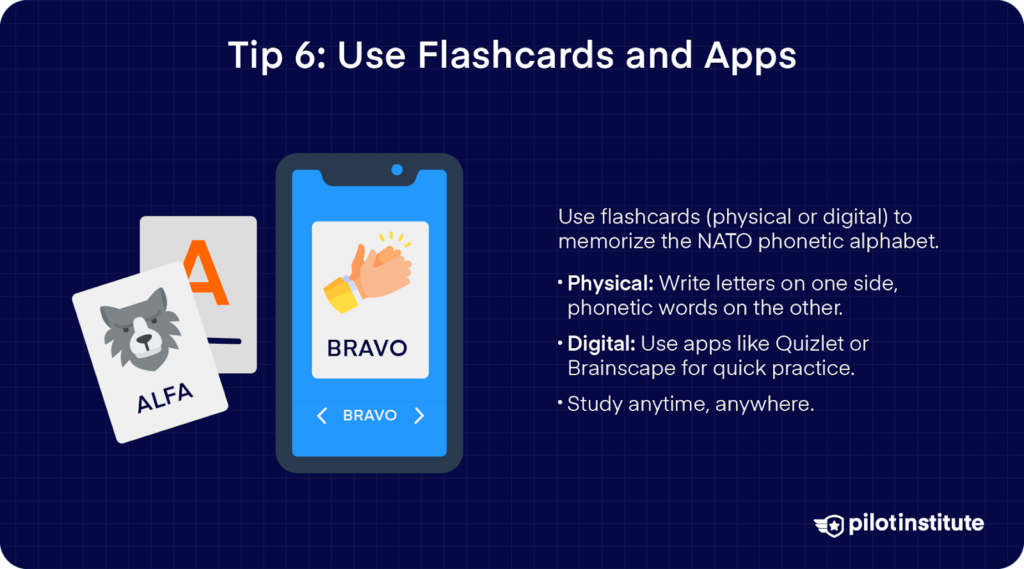
If you’re into card or video games, educational flashcards are a classic, tried-and-true way to memorize the NATO phonetic alphabet. They provide active feedback, so you’d get to check yourself right away. This way, you’ll get to learn while also being entertained.
Start by making some simple physical flashcards. Put a letter on one side and its phonetic code word on the other. Keep them handy throughout the day, and flip through the cards whenever you have a few minutes of free time.
Do you prefer to go digital? There are many flashcard apps like Quizlet and Brainscape that let you make your own personal sets. Some even include pre-made phonetic alphabet decks.
You can even take it a step further with smartphone apps specially designed to learn the phonetic alphabet. These usually feature interactive quizzes, pronunciation assistance, and progress monitoring, which can keep you encouraged and indicate how far you have progressed.
One of the best parts about flashcards and apps is that you can study anywhere, anytime. In between breaks or while waiting in line, flip through your cards! A quick review session can go a long way.
Tip 7: Repetition and Regular Practice
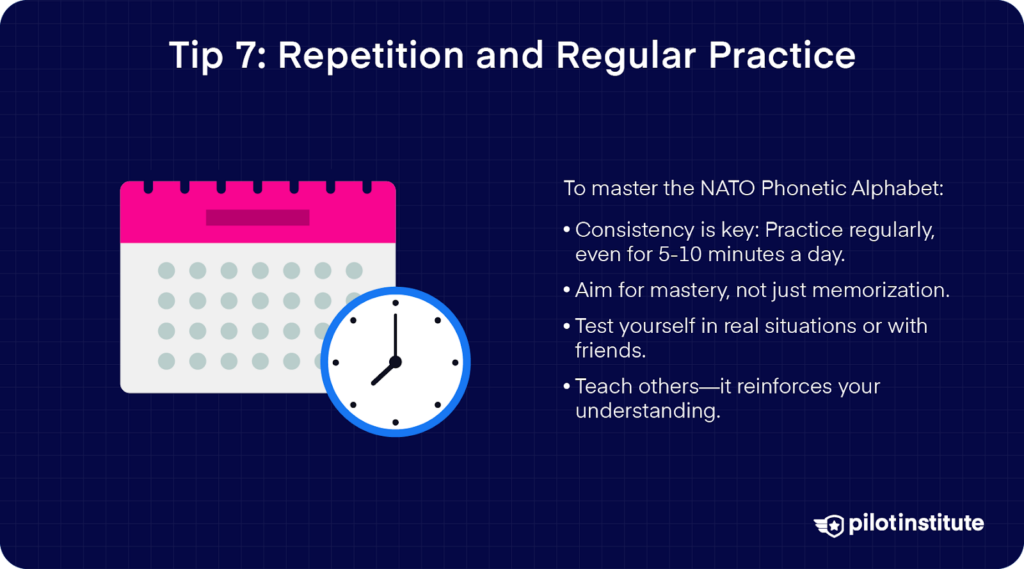
Of course, these techniques can only produce meaningful results when you practice them consistently. You shouldn’t just simply memorize the phonetic alphabet; your goal is to master it.
What does this mean? There’s a difference between knowing and understanding. You might be able to give the correct code word in an exam, or you might be able to win against your friends in a flashcard drill. Will your performance be the same in a year? Can you understand the phonetic alphabet in an emergency with lives on the line?
These situations are where mastery matters most. Psychologically, this means strengthening neural pathways. The brain has an incredible ability to change and adapt based on what we do and experience—a phenomenon known as neuroplasticity.
The catch here is that you have to stay consistent. Regular and short practice sessions—even just five to ten minutes a day—can greatly improve long-term retention. Don’t stop until you’ve got every code word by heart.
You can also boost your learning when you practice with others. Try teaching a friend or family member what you’ve learned, or challenge each other to spell words using the alphabet. Teaching reinforces your understanding. Plus, you’d get to help others, which is always a good opportunity to take.
Application of the NATO Phonetic Alphabet

You won’t just hear the words “Alfa” or “Zulu” in the cockpit. The NATO Phonetic Alphabet is used across a diverse range of industries, and even in normal, everyday conversation.
Real-Life Scenarios
Pilots and air traffic controllers use the phonetic alphabet to communicate important data like call signs and instructions. For an aircraft with callsign “AB123,” you’ll hear it referred to as “Alfa Bravo One Two Three.” Isn’t that much clearer?
In the military, the phonetic alphabet helps convey instructions and information precisely. Instead of saying “Continue mission,” our troops would say “Charlie Mike,” which gets the point across with fewer syllables.
Police officers and first responders also use the phonetic alphabet during emergencies. It helps in verifying addresses or codes. This way, emergency personnel get correct information as efficiently and accurately as possible.
Customer service agents rely on the phonetic alphabet to verify sensitive data. An incorrect account number or address could have serious consequences. The phonetic alphabet is their tool for reducing errors when talking on the phone.
Those are just a few examples of fields where the NATO phonetic alphabet is used. As you can see, it serves a significant purpose in many industries. Communication becomes clearer, and there’s less of a chance of misunderstanding.
Benefits for Civilians
Although the NATO phonetic alphabet is a necessity in aviation and the military, it’s also instrumental in day-to-day situations.
Imagine having to spell your name over the phone with poor reception and your dog barking loudly in the background. How can the other person understand you?
Spelling out names and email addresses with code words will help you avoid these annoying mishaps.
Even in business or work, using the phonetic alphabet helps you make a strong impression. As you clarify details professionally, you get to show off your strong and accurate communication skills.
Even while traveling, the phonetic alphabet can help bridge communication gaps. Because it’s internationally recognized, it can make spelling things out much easier, like when you’re asking for the subway exit or confirming a flight number.
It also has a place in education and recreation. In the classroom, teachers can use the phonetic alphabet as a playful tool in communication and language classes. For game night and puzzle enthusiasts, the phonetic alphabet can be a fun bit of trivia.
Frequently Asked Questions
Is it “ALFA” or “ALPHA”?
The FAA lists the word as “Alfa” under their learning center library contents for the NATO phonetic alphabet. This spelling was chosen to keep consistent pronunciation across languages, since non-English speakers might mispronounce “PH” as a different sound. Also, “JULIETT” is spelled with a double ‘T’ to prevent mispronunciation in languages where a single final ‘T’ might be silent.
However, using “alpha” isn’t incorrect, since the pronunciation is the same, and you are not spelling the word during radio communication; either word can be used.
What Does “Tango Mike” and “Bravo Zulu” Mean?
Sometimes, even two letters can stand as a complete sentence. These terms are used in military communication, but you can use them as a civilian, too!
“Tango Mike” is short for “Thanks Much.” “Bravo Zulu” is short for “Well Done,” and is frequently used to congratulate or compliment someone.
Take note that these are conventional shorthand expressions—basically slang—but they’re not part of the standard alphabet itself.
Other common terms you will hear are:
- Oscar Mike – Short for “On the Move.”
- Charlie Mike – Short for “Continue Mission.”
- Tango Delta – Short for “Target Down.”
- Lima Charlie – Short for “Loud and Clear.”
These meanings are based on common usage, particularly in military settings, but aren’t formally defined in standard civilian aviation communication protocols like the AIM.
But if you want to impress your video game friends, greet them with a Tango Mike on your next campaign!
How Can I Memorize the Phonetic Alphabet Quickly?
Memorizing the NATO phonetic alphabet doesn’t have to be overwhelming. The trick is to use the right techniques that match your learning style. Then, reinforce what you’ve learned through regular practice.
Everyone learns in a different way. If you are a visual learner, make colorful flashcards or stories that connect words together. If you’re gifted in music, try to say the code words out loud or use jingles. Kinesthetic learners can use writing it out over and over again.
You don’t have to learn it all at once. Short, daily practice sessions are better than cramming it all into one session. With time, the words will become natural, almost second nature.
With a bit of practice every day, you’ll get there. And when you do, you’ll also possess a skill that makes you stand out in everyday settings!
Is the NATO Phonetic Alphabet Used Worldwide?
Yes, the NATO phonetic alphabet is used everywhere on the globe. It’s the international standard for spelling out letters clearly by radio or phone. For pilots, marine navigators, or emergency responders, this alphabet keeps everyone on the same page.
When people from different countries work together, accents, language differences, and poor connections can lead to mistakes. The phonetic alphabet cuts the guesswork with universally recognized code words.
Additional Learning Resources
The great part about learning is that you don’t have to do it yourself. Professional educators have masterfully developed tons of resources for you to learn the phonetic alphabet as intuitively as possible.
Want to know how to supplement your learning? Here are some resources you can check out!
Online Quizzes and Practice Tests
If you’re trying to strengthen your memory of the NATO phonetic alphabet, online tests and phone apps can be incredibly useful.
Check out apps like Quizlet, or our very own Pilot Institute flashcard app. You’ll get access to interactive flashcards, matching games, and practice tests that actively reinforce what you’ve studied.
With apps and programs like these, passive review becomes active learning. You’ll get to feel the difference between simply recognizing information and effectively recalling it.
There are also mobile apps that are specifically geared toward the phonetic alphabet. Look for progress tracking features and customizable difficulty levels. They show a more objective measure of your progress, so you’ll get positive reinforcement and guidance on your weak spots.
The best way to get the most out of these apps? Consistent practice. Even a handful of minutes of daily practice with these tools can make substantial improvements.
Printable Materials and Visual Aids
Sometimes, the simplest things are best. If you want to go back to basics, you can download charts and posters of the NATO phonetic alphabet. They do wonders for incorporating a visual element into your routine learning.
Put these materials onto objects you encounter daily, like your desk, fridge, or a bulletin board in your office. You’ll practice something called passive exposure, where your brain absorbs information simply by seeing it repeatedly in your environment, even if you’re not actively studying it.
Want to incorporate your personality into it? Go ahead! You can also design your own visual aids to make learning more personal.
Experiment with adding your own mnemonic pictures or handwritten notes beside each code word. This way, you’ll create a deeper connection to the material.
Conclusion
Learning the NATO phonetic alphabet is entirely possible with the right approach. Know your learning style and leverage it in your studies.
There’s no wrong way to learn, but the best way is one that works for you. Stay consistent and take it one day at a time. Steady and sustained progress does wonders for strengthening those neural pathways.
We’ve learned how the phonetic alphabet is used in a bunch of different fields, from aviation to emergency response. But the benefits from learning it don’t just come from the breadth of its scope. The learning process itself will teach you techniques that you can apply to so many other topics in your life as a pilot.
So, start applying these techniques today. Add a few minutes of practice into your daily routine, test yourself in real-world situations, and don’t hesitate to teach others what you’ve learned.
The more you use it, the more natural it becomes. Keep a steady effort, you’ll be speaking “Alfa, Bravo, Charlie” like a natural in no time.
